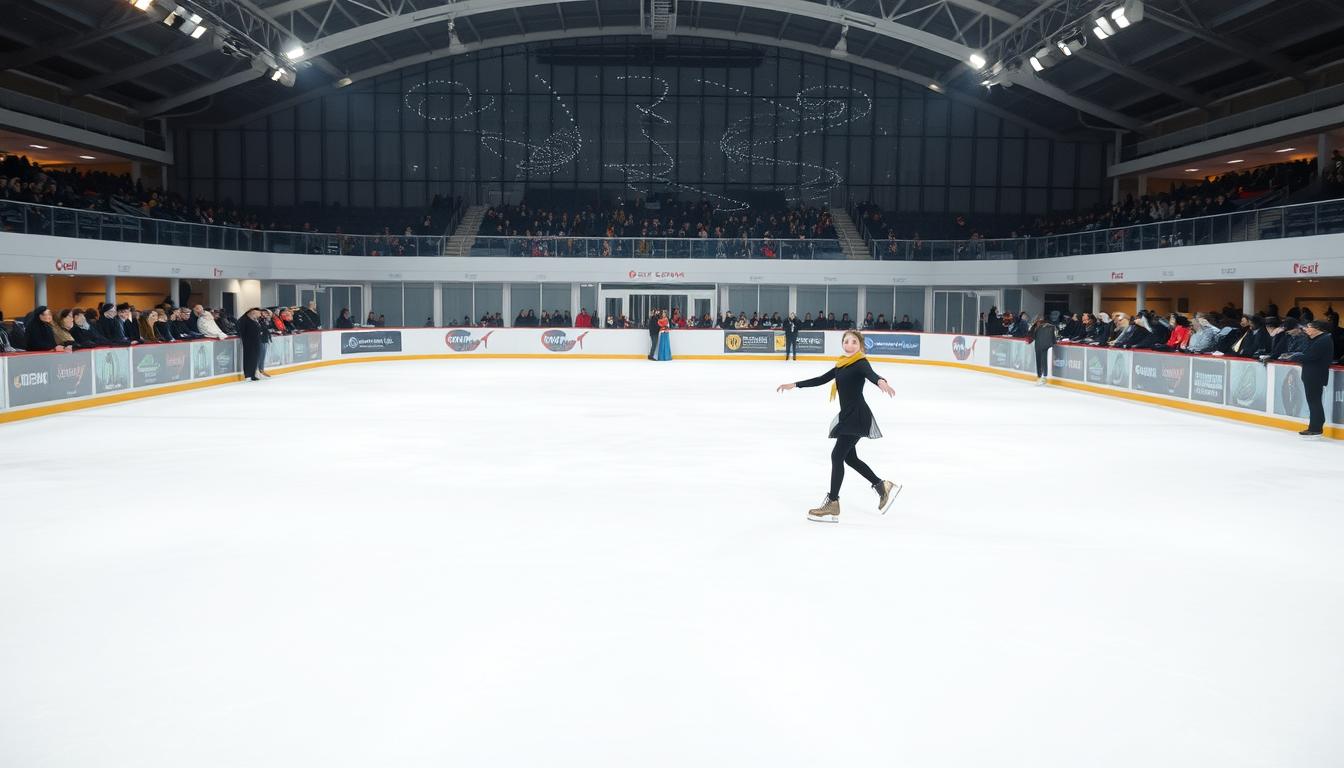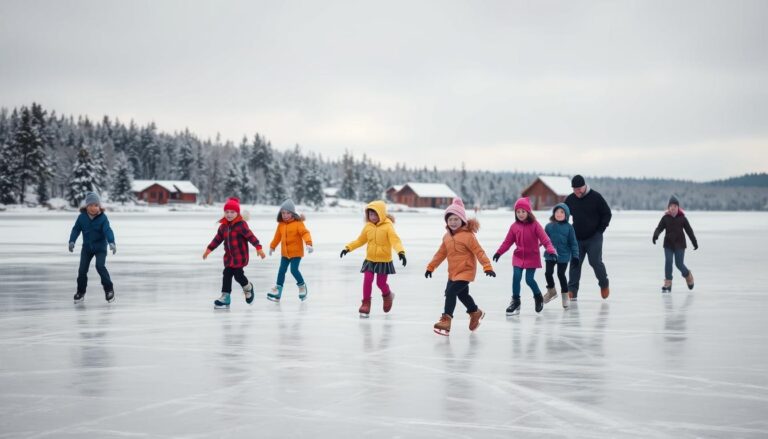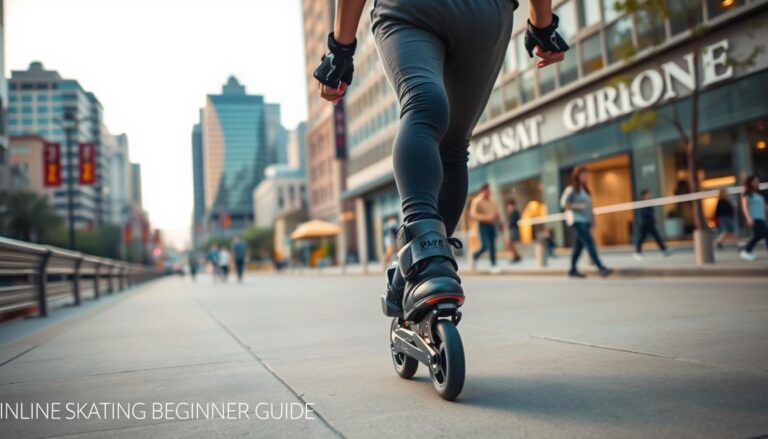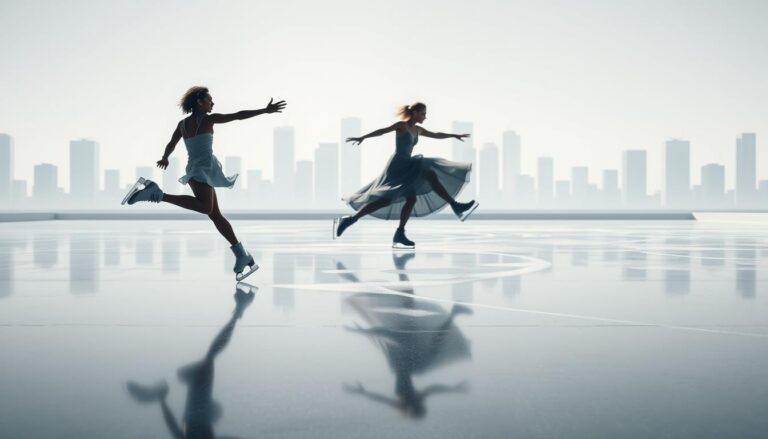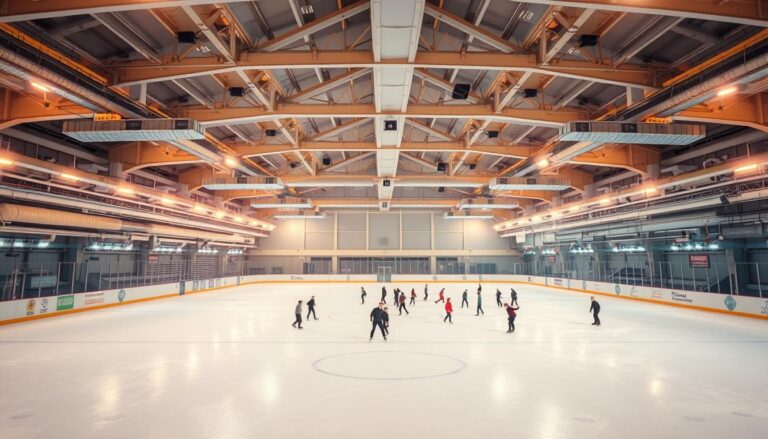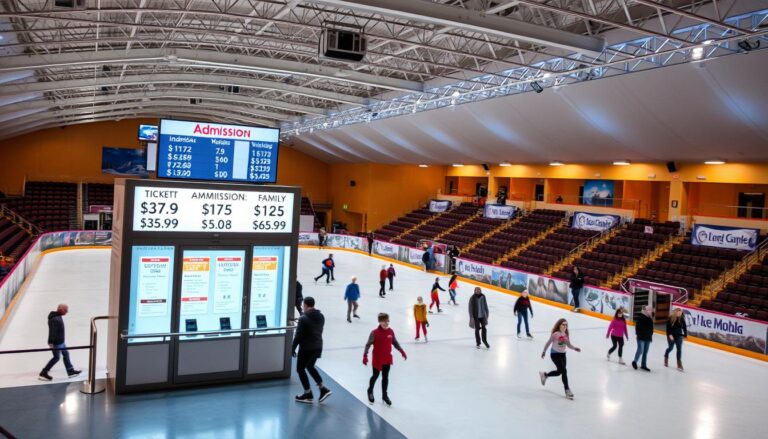The Sport of Skating: What You Need to Know
Imagine a world where motion meets precision, where athleticism blends with artistry. Skating isn’t just a pastime – it’s a dynamic sport that challenges both body and mind. Whether you’re gliding on ice, rolling on wheels, or carving through a skate park, the skating culture offers an exhilarating experience.
Is skating a sport? Absolutely. It’s not just a simple recreational activity. Skating demands extraordinary skill, strength, and technical mastery. Professional skaters train rigorously, developing exceptional balance, core strength, and cardiovascular endurance.
Each skating discipline tells a unique story of human talent. From figure skating’s elegant choreography to roller derby’s intense competition, these activities represent far more than casual recreation. They embody athletic precision, strategic thinking, and years of dedicated practice.
The skating culture spans multiple generations and styles. Urban street skaters push boundaries with gravity-defying tricks, while Olympic figure skaters perform complex routines. Speed skaters slice through competitions with lightning-fast movements, showing incredible technical skill and physical conditioning.
Understanding skating requires appreciating its complexity. It’s a sport that demands mental focus, physical prowess, and an intuitive connection between body and surface. Skaters develop muscle memory, spatial awareness, and split-second decision-making skills.
Professional skating competitions showcase the extraordinary capabilities of athletes. They have transformed this activity into a high-performance sport. International championships prove that skating requires the same dedication, training, and competitive spirit found in basketball, gymnastics, or swimming.
Whether you’re a curious beginner or an aspiring professional, the world of skating offers something extraordinary. It’s a sport that invites continuous learning, personal challenge, and remarkable physical achievement. Prepare to explore a world where motion becomes art, and athleticism knows no boundaries.
Understanding the World of Skating
Skating is more than a sport; it’s a culture of athleticism, creativity, and self-expression. It’s found on city streets and in professional rinks. Skating has become a lifestyle that draws millions of fans worldwide.
Skaters have created unique disciplines that show off their skill and passion. Let’s dive into the world of skating culture and its exciting variations:
- Inline Skating: Smooth, fast movement on special wheels
- Figure Skating: Artistic ice performances with precise moves
- Roller Derby: High-energy team sport with competitive skating
- Skateboarding: Street-style riding with tricks and urban landscapes
Different Forms of Skating Disciplines
The debate between skateboarding and skating shows each discipline’s unique traits. Skateboarding focuses on street tricks and urban creativity. Traditional skating, on the other hand, covers a wide range of styles and techniques.
Evolution of Skating Through History
Skating has changed a lot over the years. Starting as a way to get around in the 18th century, it has grown into a global phenomenon. It now includes many athletic and artistic forms.
Modern Skating Culture
Today’s skating culture mixes sport, art, and community. Fans connect through social media, local events, and international competitions. This creates a worldwide network of passionate skaters who keep pushing limits and redefining what’s possible on wheels.
Is Skating a Sport: Breaking Down the Athletic Elements
Skating is more than just a fun activity; it’s a tough sport that needs top-notch athletic skills. When asked if skating is a sport, the answer is a clear yes. It combines physical power, mental sharpness, and technical skill in ways that test even the best athletes.
Skating’s athletic side is more than just moving around. Skaters build strong cores, balance, and heart health. Professional skaters work hard, showing that skating is a real and tough sport.
- Requires intense physical conditioning
- Develops muscle strength across multiple muscle groups
- Demands exceptional coordination and body control
- Provides an excellent full-body workout
Skating’s benefits go beyond just getting fit. It boosts mental focus, spatial understanding, and fast thinking. Skaters can burn 400-600 calories an hour, similar to intense workouts.
| Skating Discipline | Calories Burned per Hour | Primary Muscle Groups Engaged |
|---|---|---|
| Figure Skating | 450-550 | Legs, Core, Arms |
| Roller Skating | 400-500 | Quadriceps, Hamstrings, Glutes |
| Ice Hockey Skating | 500-700 | Full Body |
Skating challenges athletes in unique ways, needing technical skill, physical strength, and mental toughness. Whether you skate for fun or dream of being a pro, it’s a great workout that keeps pushing athletes to new heights.
Essential Skating Equipment and Gear
Choosing the right skating equipment can make a big difference. It can turn a tough experience into a fun one. Knowing about skating gear is key for both beginners and pros.
Skating equipment is more than just skates. It’s a full set of gear that helps you skate better and stay safe. It’s important for all types of skating.
Choosing the Right Skates
Finding the right skates is important. It depends on how you skate and your skill level. Different types of skating need different shoes:
- Recreational skates: Great for casual skating in parks and trails
- Speed skates: Made for racing and fast skating
- Figure skates: For artistic and competitive ice skating
- Inline skates: Good for city and fitness skating
Protective Equipment Guidelines
Always put safety first when picking out your gear. You’ll need:
| Protective Item | Purpose | Recommended For |
|---|---|---|
| Helmet | Protects your head | All skill levels |
| Knee Pads | Protects your joints | Beginners and aggressive skaters |
| Wrist Guards | Prevents wrist injuries | New skaters and kids |
| Elbow Pads | Cushions falls | Inline and roller skaters |
Maintenance and Care Tips
Looking after your gear is important. It makes your skates last longer and skate better. Regular care is essential for safe and smooth skating.
- Clean your skates after each use
- Check the wheels and bearings
- Keep them in a cool, dry place
- Replace old parts quickly
Buying good skating equipment might cost more at first. But it’s worth it for better skating, safety, and more fun.
Fundamental Skating Techniques for Beginners

Starting to learn skating can feel scary, but it’s not hard. With the right steps, anyone can skate well. Knowing a few key skills is the first step to skating like a pro.
Here are the basic skating techniques every beginner should learn:
- Proper Stance: Keep your knees bent, weight in the middle, and arms loose. This stance helps you stay balanced and in control.
- Gliding Technique: Push off with one foot while the other foot stays steady. Switch feet to keep moving smoothly.
- Stopping Methods: Learn to stop by turning your toes in and pushing your heels out. This creates friction to slow down.
Important techniques for beginners include:
- Scissor Movement: Practice moving your feet like scissors to build speed.
- Swizzle Technique: Move by pushing your feet out and then pulling them back together.
- Basic Turning: Shift your weight and turn your body to change direction smoothly.
Experts say to practice in a safe place. Start in an open area with smooth surfaces. Wear protective gear and don’t worry if you make mistakes. Every pro started as a beginner, and practice makes perfect.
Skating is about getting better with practice and feeling confident. Take your time, be patient, and enjoy the journey. With hard work, you’ll glide like a pro soon.
Advanced Skating Skills and Movements
To get better at skating, you need to learn advanced techniques. These skills turn simple skating into a professional sport. It’s not just about moving; it’s about doing it with precision, power, and style.
For those wanting to improve, focus on the basics that make you stand out. Learning advanced techniques takes time and effort. It’s all about practice and the right training.
Speed and Control Techniques
Speed in skating comes from mastering body movements and precise actions. To get better, try these:
- Mastering the double push technique
- Building strong core muscles
- Improving edge control
- Working on stride mechanics
Artistic Elements in Skating
Artistic skating is more than just moving fast. It’s about combining skill with creativity. Key parts include:
- Moving smoothly
- Following precise choreography
- Telling stories with your body
- Smoothly changing movements
Professional Training Methods
Top skaters use special training plans to reach their best. Good training includes:
| Training Focus | Key Components | Frequency |
|---|---|---|
| Physical Conditioning | Strength Training | 4-5 times weekly |
| Technical Skill Development | Technique Drills | Daily practice |
| Mental Preparation | Visualization Techniques | 2-3 sessions weekly |
By learning these advanced techniques and training methods, you can improve. Becoming a pro skater takes hard work, dedication, and a love for the sport.
The Physical and Mental Benefits of Skating
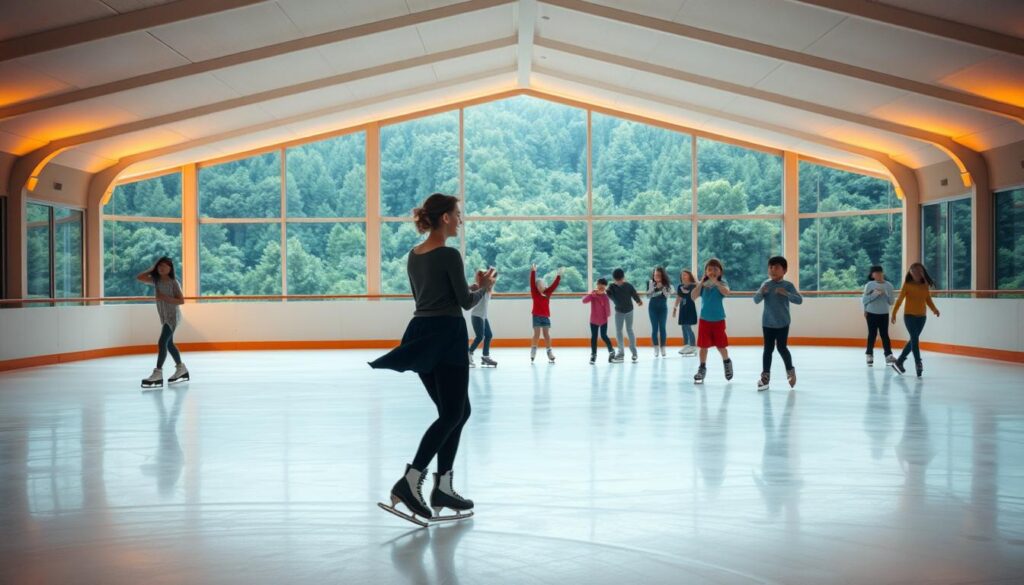
Skating is more than just fun; it’s a workout for your body and mind. It offers many benefits that improve your health and well-being.
Skating boosts your heart and burns calories. It’s a great way to stay fit and healthy. Skaters can burn up to 600 calories per hour, depending on how hard they skate.
- Strengthens leg muscles
- Enhances core stability
- Improves balance and coordination
- Increases overall flexibility
Skating also helps your mental health. The rhythmic motion can be calming and lifts your mood. Skating allows you to enter a flow state, where you focus and enjoy the moment.
| Skating Type | Calories Burned (per hour) | Primary Muscle Groups Engaged |
|---|---|---|
| Roller Skating | 350-450 | Quadriceps, Hamstrings, Calves |
| Ice Skating | 450-600 | Core, Glutes, Lower Back |
| Inline Skating | 400-500 | Entire Lower Body, Core |
Skating is great for athletes and fitness lovers. It’s not just a workout; it builds mental strength, spatial awareness, and confidence.
Major Skating Competitions and Events
Skating competitions are the top of athletic skill and art. Athletes from all over the world show their amazing abilities in skating events. These events get a lot of attention and inspire many fans.
Competitive skating has many places for athletes to show their talents. Events range from local to international, each with its own challenges and chances for skaters.
International Championships
Top athletes from many countries compete in elite skating events. These events focus on different skating areas:
- World Figure Skating Championships
- ISU World Speed Skating Championships
- World Roller Skating Championships
Olympic Skating Categories
The Olympic Games are the biggest stage for skating. Athletes compete in special categories that show off their skills:
- Figure Skating (Singles, Pairs, Ice Dance)
- Speed Skating (Short Track, Long Track)
- Synchronized Skating
Regional Competitions
Regional events are key for new talents. They help athletes move up to national and international levels.
Skaters can find local tournaments for valuable experience. Passion, dedication, and practice are essential for success in skating.
Building Your Skating Practice Routine
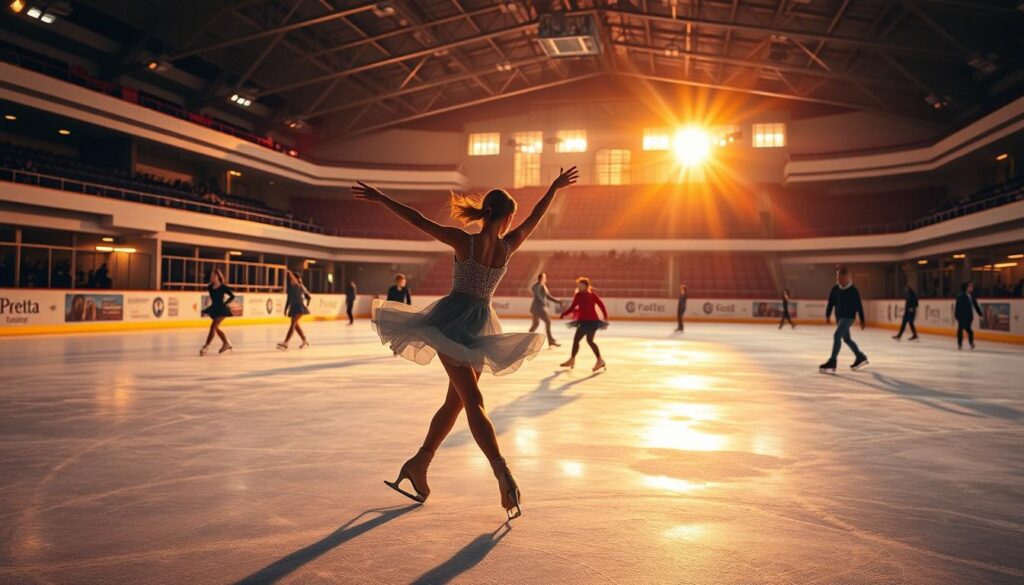
Creating a solid skating practice routine can take your skills to the next level. It’s all about balancing technique, endurance, and your personal goals. This balance is essential for mastering skating techniques.
First, figure out your current skating level. Then, pinpoint areas where you need to get better. This will help you focus your practice.
- Assess your current skating abilities
- Set clear, measurable skating goals
- Design a personalized training schedule
- Track your progress consistently
Experts say to break your practice into parts. Start with warm-up exercises to get your body ready. Then, do technical drills to improve your skills. Finish with cool-down stretches to avoid injuries.
A typical practice session might include:
- 10-minute dynamic warm-up
- 20-minute skill-specific training
- 15-minute endurance work
- 10-minute flexibility and recovery
Consistency is key in mastering skating techniques. Stick to regular practice. As you get better, add more challenging exercises to your routine.
Always listen to your body and stay hydrated. Make sure you have the right equipment to get the most out of your practice.
Safety Measures and Injury Prevention
Skating is an exciting sport that requires skill and caution. It’s important to know how to protect yourself when using skating gear. Every skater, from beginners to pros, needs a solid safety plan to stay safe and have fun.
Skating can lead to injuries if you don’t take the right precautions. Learning the right techniques and using the right gear can lower your risk of getting hurt.
Common Skating Injuries
Skaters often face certain injuries that need special prevention:
- Wrist sprains from falls
- Ankle twists during complex maneuvers
- Knee strains from improper landing techniques
- Head impacts from unexpected collisions
Prevention Strategies
Protecting yourself begins with choosing the right gear and learning proper techniques:
- Wear complete protective gear
- Practice falling correctly
- Build core strength and balance
- Learn from experienced instructors
Emergency Response Protocol
Acting fast and knowing what to do can help a lot. Always have a first-aid kit nearby and know basic emergency steps. If a serious injury happens, stay calm and get medical help right away.
By following these safety tips and using the right gear, you can enjoy skating while staying safe.
Joining the Skating Community

Stepping into the skating community is thrilling. It’s a place of excitement, friendship, and shared passion. Whether you’re new or have been skating for years, meeting others who love it as much as you do can change your experience. It turns a solo activity into a lively social journey.
The skating culture is more than just skating. It’s about making friends, sharing moments, and growing together. Here are some ways to connect with the skating community:
- Join local skating clubs in your area
- Participate in online skating forums
- Follow skating groups on social media platforms
- Attend skating events and meetups
- Take group skating classes
Online platforms have changed how skaters meet. Platforms like Facebook groups, Reddit communities, and specialized skating forums are great for meeting others, sharing tips, and finding out about events.
Local skating groups offer special benefits. They provide a place to improve, make friends, and dive into skating culture. Many cities have clubs for all skill levels, creating a supportive space for learning and fun.
Pro tip: Don’t be shy! The skating community is welcoming and supportive. Most skaters are happy to share their knowledge and help newcomers feel at ease.
Begin your adventure today by reaching out, showing up, and embracing the amazing world of skating connections!
Professional Skating Career Paths
Professional skating is full of exciting opportunities for those who love to skate. It’s not just about competing. There are many career paths for those who enjoy gliding on wheels or blades.
There are many ways to turn your passion for skating into a career. You can find a path that suits you well.
Training Requirements
To become a pro skater, you need hard work and dedication. The journey includes:
- Extensive physical conditioning
- Technical skill development
- Specialized coaching
- Consistent practice regimens
Career Opportunities
There are many career paths in professional skating:
- Competitive Athlete: Compete in national and international events
- Skating Instructor: Teach skating to all levels
- Performance Artist: Perform in shows and exhibitions
- Equipment Technician: Work on skate maintenance and design
Success Stories
Many skaters have made their passion into successful careers. Olympic medalists and world champions often become coaches or work in sports management.
Success in professional skating comes from talent, hard work, and networking. Always improve your skills and make connections in the industry.
Indoor vs. Outdoor Skating: What to Know
Choosing between indoor and outdoor skating can change your skating experience. Each place has its own challenges and chances for skaters to improve their skills and pick the right gear.
Indoor skating is great for beginners and experts. It has smooth floors and steady temperatures, perfect for learning hard moves. Rinks are set up for you to work on your skills.
- Controlled temperature and surface
- Consistent lighting
- Structured practice environment
- Professional supervision
Outdoor skating is full of fun challenges. Street and trail skating need you to be flexible and use gear made for different paths and weather.
| Skating Environment | Surface Type | Recommended Equipment |
|---|---|---|
| Indoor Rink | Smooth, polished floor | Soft wheel, indoor skates |
| Outdoor Trail | Concrete, asphalt, mixed terrain | Hard wheel, durable skates |
Your choice depends on what you like, your skill level, and what’s available locally. Professional skaters often train in both environments to develop complete skills.
Always wear the right safety gear, no matter where you skate. Knowing the challenges of your skating spot is key to staying safe.
Conclusion
Skating is more than just a fun activity. It’s a dynamic sport with lots of variety. Whether you enjoy figure skating’s artistry or inline racing’s speed, there’s something for everyone. Skating offers physical, mental, and social benefits.
It’s perfect for those looking for a workout or a new challenge. Skating is easy on the body, making it great for all ages and fitness levels. You can skate in parks, rinks, or trails, turning them into your playground.
Every skater’s journey is different. Some might find a competitive edge, while others love it for the joy of moving. Start, learn, and be patient with yourself. Even pros like Michelle Kwan and Apolo Ohno began as beginners.
Your skating adventure is waiting. Get the right gear, stay safe, and join local skating groups. The skating world is eager to welcome you, promising fun, growth, and endless possibilities.
